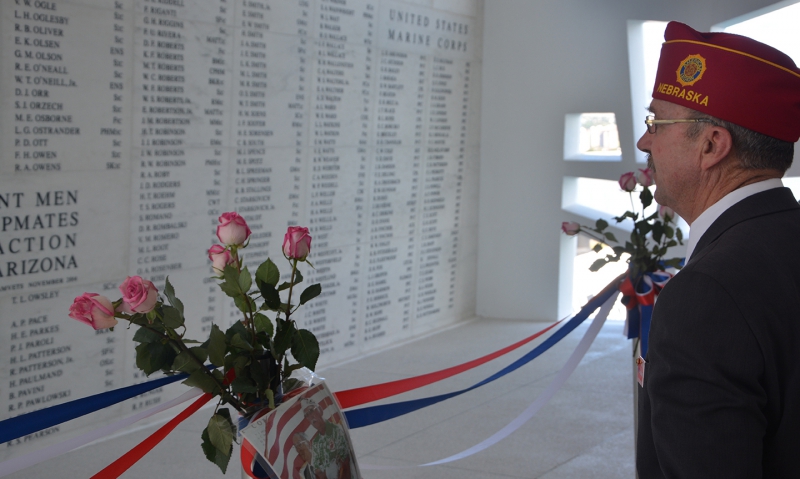
‘Infamy’
There were about two dozen. And that was just those who were in uniform during the “day of infamy.” It’s hard to get a precise count of how many Pearl Harbor survivors attended this year’s Pearl Harbor Day Commemoration in Hawaii Dec. 7, since virtually everybody who was on the Hawaiian islands during the attacks – infants to the elderly – was a potential target and, like the rest of the world’s population, would be impacted by the events to follow.
Not only is Dec. 7 permanently etched in the mind of Bob Addobati, but so is Dec. 6, 1941. “There was a battle of the band contest in Chinatown that night,” recalled Addobati, who was a 19-year-old signalman on the USS Solace that day. “All the ships had different bands. I spoke to several sailors from the USS Arizona’s band. Eight hours later every sailor in that band was dead.”
Addobati, who founded the Pearl Harbor Survivors Association chapter in Sacramento, Calif., had a clear view of the devastating attack. “I was standing watch on the quarterdeck and saw the first wave of planes come in,” he said. “The Arizona was next to us. I saw the explosion.”
For the next two days, Addobati was retrieving the dead and wounded from the water. “I think every battleship in the harbor took a torpedo,” he said.
Proudly clad in one of his old Navy uniforms, former Chief Petty Officer Ed Borucki was warmly greeted by American Legion National Commander Mike Helm following the commemoration. Borucki, who is a past district commander from The American Legion Department of Massachusetts, recalls seeing a film the night before the attack. “I saw ‘Hold Back the Dawn.’ Now how significant was that!” he said. “I knew we were under attack when the general alarm sounded telling us to ‘man your battle station. This is no drill.’”
Borucki lost 33 shipmates aboard the USS Helena, and he fears that history could repeat itself. “If we’re not prepared, we may face another Pearl Harbor,” he said. “We have to prepared all the time.”
Helm agreed. “As veterans, we must support these guys,” he said. “And we must always have a strong military and be prepared for any kind of attack. Defense and care for veterans are two of the pillars on which The American Legion was founded.”
Addobati, who later lost a leg after his ship was torpedoed at the Admiralty Islands, believes the warning signs of the attack were missed by those in charge. “We broke codes and everything indicated something was up,” he said. “At about 4 a.m. that morning, the USS Condor made contact with a Japanese sub and radioed ashore. They were radioed back that it was just a blackfish. They responded that ‘if it’s just a blackfish, it’s got a propeller up its ass.”
By 7:55 am, the attack was fully underway. By days end, 2,390 men, women and children would be killed.
Sons of the American Legion National Commander Mike Moss says that there is a strong possibility that some of his group’s founding members were lost that day. “The Sons of The American Legion was founded in 1932, by mostly very young men,” he said. “By 1941, many of these men were military age, and the strong possibility exists that some of the casualties could have been our members. Paying tribute to these veterans – and, in fact, all veterans – will always be at the forefront of our organization.”
American Legion Auxiliary National President Janet Jefford echoed the sentiment. “Visiting Pearl Harbor and talking to the survivors of that Sunday morning in 1941, helped me remember what others have sacrificed for us,” Jefford said. “I believe that it is only by learning from the past that we can plan for the future. It is important that we never forget.”
Gen. Lori J. Robinson, commander of Pacific Air Forces, delivered the keynote address at the commemoration. “In the headquarters lies a memorial called the Courtyard of Heroes,” she said. “In it sits a display case that houses the flag which flew over Hickam Field during the attack. After a failed bomb attack on the flag, Japanese Zeros attempted to cut the flag off the flagpole with a heavy stream of bullets. Although torn and tattered, Old Glory continued to wave in the midst of all the destruction. Following the attack, the flag was lowered and placed in safekeeping. Soon after, it was shipped to Gen. Hap Arnold, Chief of the Army Air Forces, in Washington, D.C. For the next five years, the flag was showcased in bond rallies throughout the United States, raising support for the war effort. Now, as it did then, it symbolizes the unbreakable American spirit.”
An unbreakable spirit that still exists today in survivors such as John Mathrusse, 91. “When I saw the Japanese, all I had was rifle,” he said. “I knew that I wasn’t going to bring any of them down with my 30-cal, but I just kept firing away.”
It’s a spirit that would be in rich abundance among the 16 million U.S. military veterans, who ensured that freedom prevailed during the next four years of the world’s costliest war.
